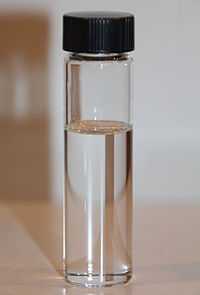
Photo from wikipedia
Over the full molar fraction range, the density, viscosity, refractive index, conductivity and pH at the temperatures (298.15, 308.15, and 318.15) K, mixing enthalpy at T = 298.15 K, and 1H-NMR were measured for… Click to show full abstract
Over the full molar fraction range, the density, viscosity, refractive index, conductivity and pH at the temperatures (298.15, 308.15, and 318.15) K, mixing enthalpy at T = 298.15 K, and 1H-NMR were measured for the binary mixtures of x N-methylimidazole (hereafter abbreviated to N-mim) + (1 − x) methanol, together with ab initio calculations. The thermodynamic parameters of activation for viscous flow were calculated and analyzed. The excess molar volume, viscosity deviation, deviation for the logarithm of viscosity, refractive index deviation and the excess refractive index, excess Gibbs energy of activation of viscous flow and the molar mixing enthalpy were calculated and fitted with a Redlich–Kister equation. The partial molar mixing enthalpies and the protons’ chemical shift changes of N-mim and methanol were calculated and explained. An increase in temperature leads to the excess molar volume becoming more negative, whereas the deviations for the logarithm of viscosity, viscosity deviation and the excess Gibbs energy of activation of viscous flow become less positive; in contrast the refractive index deviation and the excess refractive index become less positive at first and then become more positive. The activation of the viscous fluid is a more ordered process. The physicochemical properties, ab initio calculations, combined with the 1H-NMR results reveal that the molecular interactions among unlike molecules is stronger than that between like ones. There is an ionization process and hydrogen bond interaction between N-mim and methanol, the predominant interaction is N-mim:methanol = 1:1 hydrogen-bonded network, where the methyl groups of methanol and N-mim, respectively, are electron-withdrawing and electron-donating groups.
Journal Title: Journal of Solution Chemistry
Year Published: 2018
Link to full text (if available)
Share on Social Media: Sign Up to like & get
recommendations!